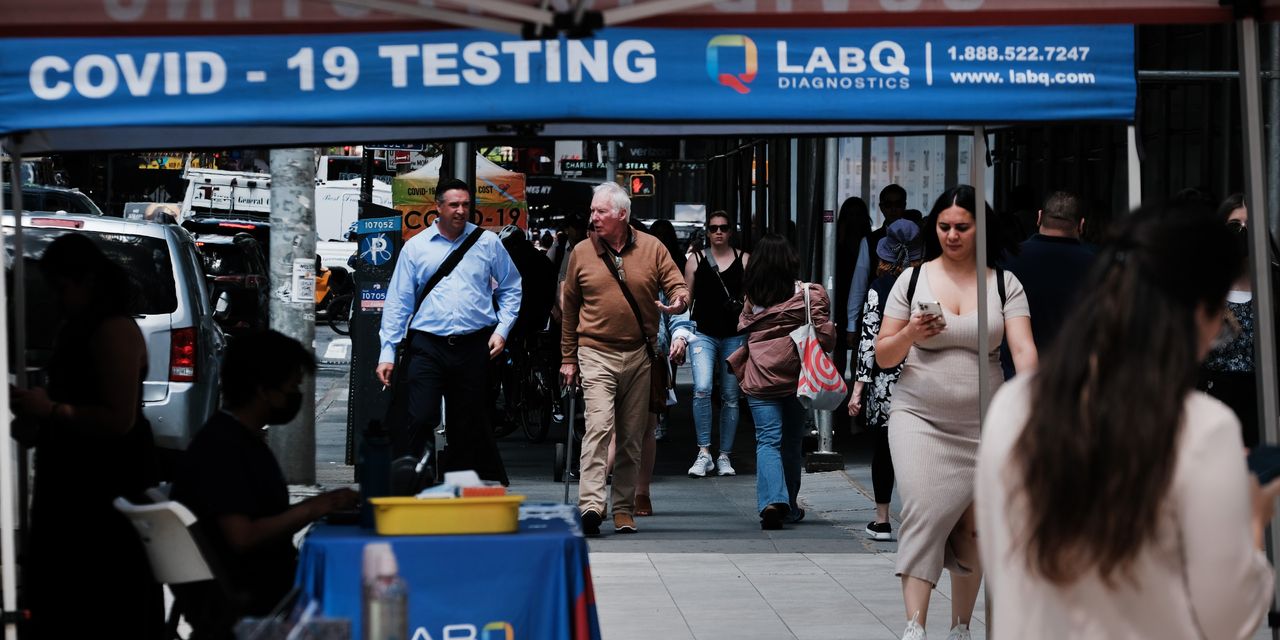U.S. known cases of COVID are continuing to ease and now stand at their lowest level since early May, although the numbers need to be viewed gently, given the number of people testing at home, where the data are not being collected.
The daily average for new cases stood at 68,312 on Monday, according to a New York Times tracker, down 24% from two weeks ago. Cases are now rising in just five states — Kentucky, South Carolina, Texas, New York and Missouri.
New York had seen a steady decline in new cases in recent weeks with 79% of its residents fully vaccinated, but the now dominant omicron subvariants are highly infectious and patients can easily become reinfected. Experts are still emphasizing that vaccines and up-to-date boosters are the best safeguard against severe disease and death.
The daily average for hospitalizations is down 10% at 34,404, while the daily average for deaths is down 20% to 382, the tracker shows.
An Associated Press poll of Americans’ views of their healthcare system produced a failing mark, with most people saying it is not handled well and its inadequacies were highlighted during the pandemic.
The poll from the Associated Press–NORC Center for Public Affairs Research found satisfaction with the U.S. healthcare system to be very low, with fewer than half of those surveyed saying it is generally handled well.
Only 12% say it is handled extremely or very well. Americans have similar views about healthcare for older adults.
Overall, the public gives even lower marks for how prescription-drug costs, the quality of care at nursing homes and mental-health care are being handled, with just 6% or less saying those health services are done very well in the country.
“Navigating the American healthcare system is exceedingly frustrating,” A. Mark Fendrick, the director of the University of Michigan Center for Value-Based Insurance Design, told the AP. “The COVID pandemic has only made it worse.”
Exhaustion and burnout among healthcare workers is one factor driving a walkout by nurses in Minnesota, a protest that started on Monday and is expected to last through Wednesday.
Coronavirus Update: MarketWatch’s daily roundup has been curating and reporting all the latest developments every weekday since the coronavirus pandemic began
Other Covid-19 news you should know about:
• The Chinese government’s zero-COVID policy has caused public discontent in cities enduring lockdowns and is hurting economic growth, based on recent data. But President Xi Jinping, who is expected to seek an unprecedented third term at the coming Communist Party congress, which kicks off Oct. 16, will not want to see any uncontrollable rise in cases until his political future is secured, CNN reported. Expert papers criticizing the zero-COVID policy are being scrubbed from the web.
• Part of China’s problem is its reliance on domestic vaccines that are not as effective or long-lasting as others, as MarketWatch sister publication Barron’s reported. Vaccination rates look good on paper: Some 90% of the population has had at least one jab of Chinese-produced Sinovac or Sinopharm
1099,
and 56% are boosted, according to Matt Linley, who tracks the disease globally as analytics director for U.K.-based Airfinity. How well those shots work is another matter. Whether through secretiveness or lack of capacity, China has never delivered solid, peer-reviewed data for its vaccines, which rely on traditional “dead virus” technology. A Hong Kong study, the best one out there for now, found, roughly speaking, that it took three shots of Sinovac to provide the same protection as two injections of the mRNA-based vaccines created by U.S.-based
PFE,
with its German partner BioNTech
BNTX,
or by Moderna
MRNA,
• The European Medicines Agency recommended the authorization of a tweaked booster dose of the Pfizer-BioNTech coronavirus vaccine that includes protection against two of the latest versions of omicron, as countries look to bolster their immunization programs ahead of winter, the AP reported. The EU regulator said Monday that laboratory studies suggest the combination vaccine — which targets both the original COVID virus as well as the omicron subvariants BA.4 and BA.5 — should trigger an effective immune response.
Here’s what the numbers say
The global tally of confirmed cases of COVID-19 topped 609. 2 million on Tuesday, while the death toll rose above 6.51 million, according to data aggregated by Johns Hopkins University.
The U.S. leads the world with 95.3 million cases and 1,050,798 fatalities.
The Centers for Disease Control and Prevention’s tracker shows that 224.1 million people living in the U.S. are fully vaccinated, equal to 67.5% of the total population. But just 108.8 million have had a booster, equal to 48.5% of the vaccinated population, and just 22 million of the people 50 and over who are eligible for a second booster have had one, equal to 34% of those who had a first booster.


